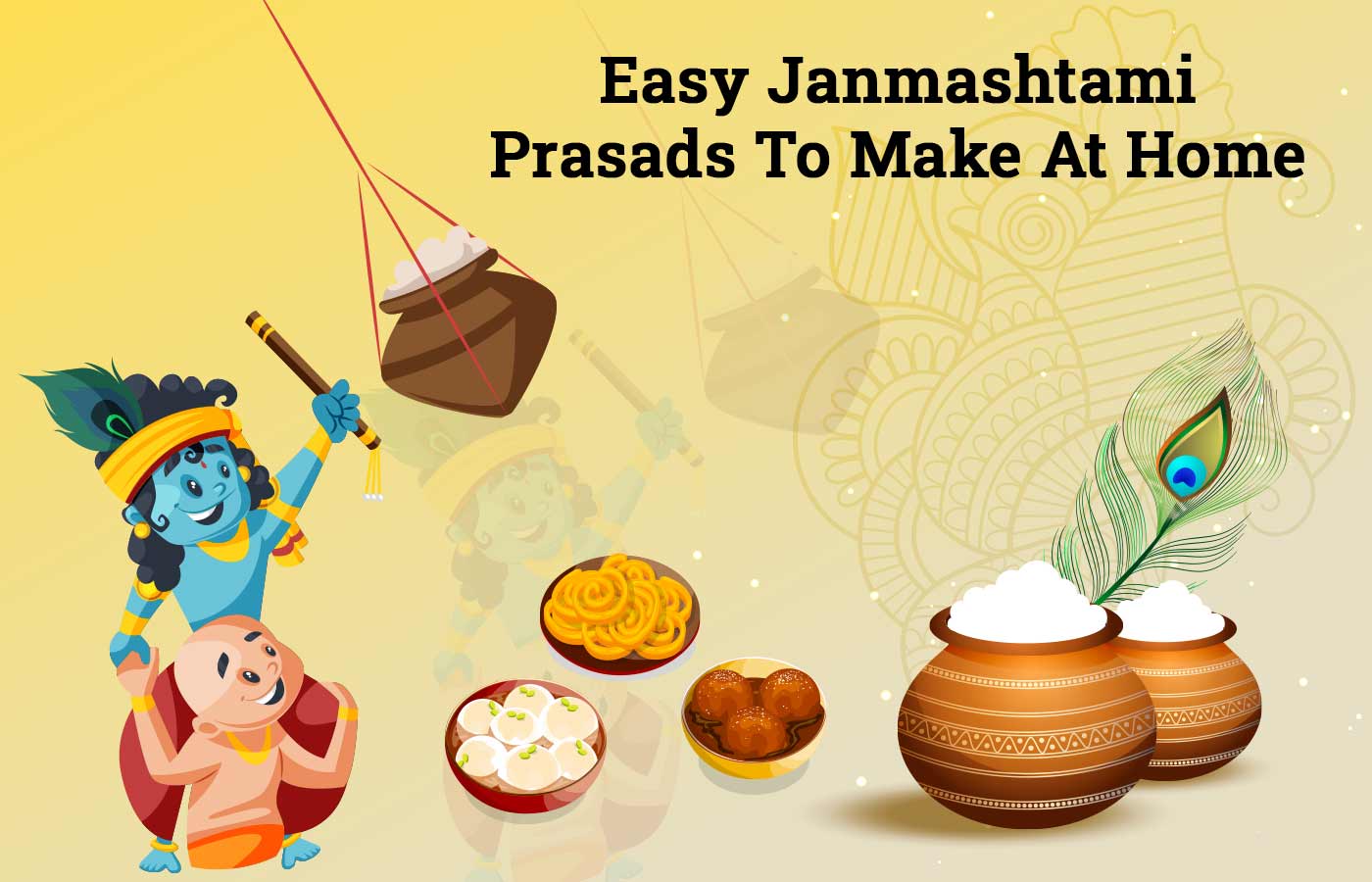
Easy Janmashtami Prasad To Make At Home
As a child, we know Krishna as someone who loved to eat, dress-up, dance, play the flute, and also kill demons of the ugliest kind. As children while listening about Shri Krishna, many times we would feel greedy and also wish, we were the ones tasting the butter instead of Krishna in the story.
Janmashtami prasad lures all, small and big equally. If you follow the eyes of children whether at home or in temples, they would be seen eyeing the prasad alone. So, if you have loved the Janmashtami prasad and wondered how it is made, then let us share some recipes with you here.
Janmashtami bhog in temples consists of 56 different types of recipes. However, it is not the same at homes where preparing so many recipes are not possible in one day time.
Thus, to please Krishna and the guests you can make some easy to make Janmashtami prasad recipes in no time even at home. Serve all with heartily the Krishna Janmashtami wishes and the Janmashtami prasad.
Ten easy to make Janmashtami Prasad at home
Let us find out how to make Janmashtami prasad at home.
- Prasad segment
1) Makhan Misri
Nothing tough in making these Janmashtami prasad recipes, I must say. If you have heard of white butter or home-made butter, you can take some of it in a clay pot and then mix crystallised sugar into it. Mix it nicely together and then refrigerate it for one hour.
If you have ever been to Vrindavan you might have observed small tiny clay pots with lids in front of Lord Krishna. In these clay pots the God is offered to Makhan Misri. It is considered to be the favourite food of Lord Krishna.
2) Dhania Panjiri
This is the most popular Janmashtami prasad served to people. One of the most popular dishes, in fact, served to Krishna as prasad in almost every temple. Dhania Panjiri was another favorite food of Shri Krishna. Making Dhania Panjiri is also quite easy. You need an equal amount of dhania powder and sugar crystals, ghee or butter, tiny pieces of pistachio, hazelnuts, raisins, almonds, and cashew nuts. Chop the nuts into fine pieces before adding to the mixture of dhania powder and sugar slightly heated together in ghee.
Let it cool for some time and dhania Panjiri is ready for you. It is considered to be a gut cleaner and helps in digesting lots of fatty food. It is mainly popular in Uttar Pradesh, Bihar, and Punjab.
3) Gopalkala
It is known to be the prasad Sudama used to bring for Krishna whenever they had enough to eat at home. It is made with beaten rice, cucumber pieces, grated coconut, ghee, sugar, roasted cumin seeds. This is one of the easiest Janmashtami prasad recipes and is known as the poor man’s food.
To make gopalkala you have to mix all the ingredients and prepare it in laddoo form (compress it with your palms to make it round) before serving it to God.
4) Sabudana ki Khichdi
One dish that can help you fast is the Sabudana khichdi. However, on the evening before Janmashtami, this Sabudana Khichdi can also be served to Krishna as the prasad. It is made of the soaked Sabudana, green chilli chopped into fine pieces, mountain salt, soaked peanuts, tomato, and a lot of ghee.
You need to add tomato to the ghee along with cumin seeds and chilli flakes. Add the peanuts to it. Cook for 4-5 minutes and then add the Sabudana over it and then garnish it with freshly chopped coriander leaves.
Sprinkle some salt.
You can either give to God without salt or with salt according to your beliefs. Sabudana ki khichdi is a palatable and light Janmashtami prasad recipe.
5) Makhana Paag
Do you know, you can mix lotus seeds with milk, ghee and powdered sugar to create a sweet dish called Makhana paag. It just needs 15 minutes and you just have to cook the sugar and milk together before anything. After the consistency thickens you need to add the ghee roasted makhana into it.
Stir it slightly and ensure you do not break off the makhana. One of the lip smacking janmashtami prasad recipes to be made at home.
Makhana is nothing but the lotus seeds carefully roasted and is one of the favourite foods of Shri Krishna.
- Sweet segments
Usually 5-10 desserts are served to God in the temples as part of the 56 recipes.
At home, you can try making these five. They are not only easy to make but also do not require your attention. Just leave them on the stove or work around them for some time and they are all ready.
6) Rabri
Rabri is nothing but the thick, creamy milk coagulated after heating for a long time. Milk is evaporated and what remains below is a residue that when mixed with sugar crystals becomes Rabri. You can serve it as a dessert to God. One of the tastiest sweets you can serve to Krishna as part of Janmashtami prasad.
Just leave the milk in the gas for long. Almost 3 litres of milk can create 750 grams of Rabri. So, whenever you get time, come over and remove the thick layer of cream from the milk. Do it as long as possible. Later, leave the milk to condense. Once it is quite condensed, place those layers of cream one layer above the other and if possible, refrigerate it for the night.
7) Phirni
It is kheer made with broken rice, milk and sugar. Phirni is a sweet dish that is an affordable and quick Janmashtami prasad recipe.
First cook the milk for some time. Add the sugar to it. You can instead add some jaggery and some cardamom into it. Let the milk boil for some more time and then add the broken washed rice grains on it. Cook it for some time and then serve it hot.
8) Sweet curd
Prepare sweet curd from caramelized milk, plain curd, and sugar when mixed together and refrigerated post mixing all the ingredients together.
Sweet curd is not a typical Janmashtami prasad recipe, but typically a sweet dish savoured normally in North India.
If you are ever short of time, while wondering how to make five sweet recipes for Janmashtami at home, then add this up and you won’t even need an hour for it separately.
9) Coconut Ladoo
Coconut ladoo is another recipe that can be easily made at home.
For a wonderful coconut ladoo recipe, warm the milk at home. Once the milk is condensed, put some sugar in the container and liquify it. Add the grated coconut and the condensed milk into it.
Slowly mix them all together. Check if the sugar is sticky enough or else add a little more sugar. You can also use jaggery instead of sugar. Now, let it cool a little.
Take small chunks of them in your palms and press them together to create any shape of ladoo.
Janmashtami recipes that come from the southern lands primarily since coconut in earlier days mainly grew in their lands.
10) Rasmalai
Bring milk to a boil for some time. Add saffron to it and add small green cardamom to the preparation. Add almonds, and then sugar to taste. Keep it aside.
Take paneer in a plate, cut them into desired pieces. To the water add a lot of sugar and place the paneer pieces into it. Finally, once done add the Paneer pieces into the milk and let it remain in the milk overnight.
Garnish it with some fresh saffron pieces. Yummiest is all I can say about this Janmashtami recipe.
Conclusion
In this article, we have combined some ten easy recipes for Janmashtami festival that you can serve to the Lord for this Janmashtami. Even though it is Janmashtami amid lockdown, you need not go out a lot to get these products. Some of them are present in your home and the only challenge is to acquire so much milk and paneer.
I am sure after going through all these recipes, you are no longer scared as to how you can use your one day and also make some good recipes for Shri Krishna. If you are also not a great cook, even then the recipes mentioned in this list will not be too daunting a task for you. So, I am sure, I have answered how to make Janmashtami prasad at home largely. If there is anything else that you would like to know, don’t hesitate to leave your comments in the comment box for us to reply.
Wish you a happy Janmashtami ahead! Hopefully, you will still have enough time after preparing these sweets to celebrate the day with your near and dear ones.
















